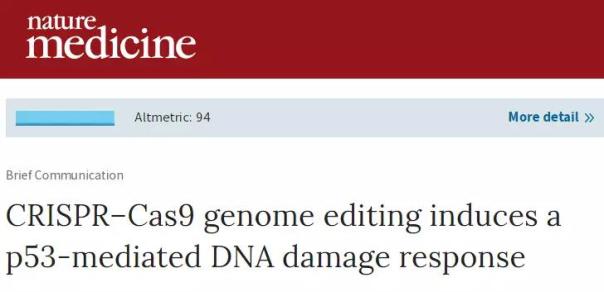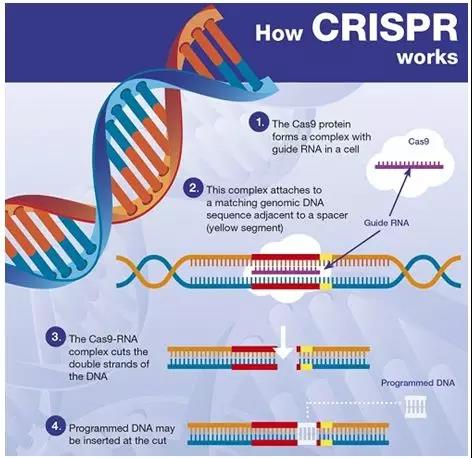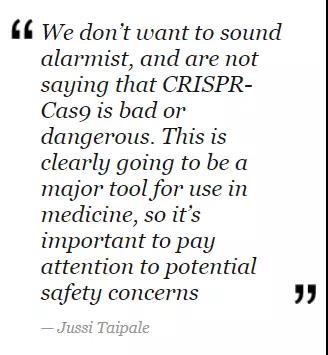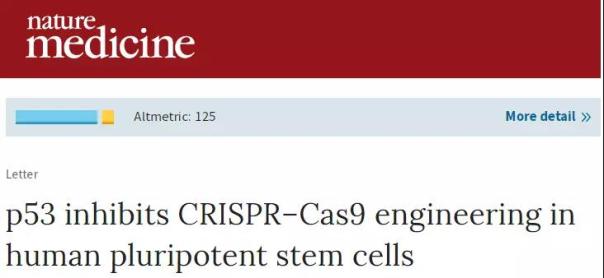pour cold water on! Nature Supplement: CRISPR or increase cancer risk
Release date: 2018-06-13
Known as the "century discovery" gene editing tool CRISPR has revolutionized biomedical research and brought new hope for the treatment of many diseases. However, on June 11, two papers published in Nature Medicine poured cold water on this "magic cut"! The study said that using CRISPR-Cas9 may have unintended consequences - increase the risk of cancer! The results have been heated up after the publication of the results, but also caused the stock price of the relevant companies to fall!

Image source: Nature Medicine (doi:10.1038/s41591-018-0049-z)
01. Paper 1
In a paper entitled "CRISPR-Cas9 genome editing induces a p53-mediated DNA damage response", a team led by Professor Jussi Taipale from the Karolinska Institute in Sweden found that CRISPR-Cas9 triggered a protection against DNA damage. Mechanisms, which make gene editing more difficult. Cells that lack this protective mechanism are more easily edited than normal cells.
"We found that editing the genome of a cell with CRISPR-Cas9 induced the activation of a protein called p53, which acts like a cell's 'alarm system', signaling a DNA damage and opening DNA damage.' First Aid Kit'. It is this system that makes it harder to edit the genome of healthy cells," explains Dr. Emma Haapaniemi, co-first author of the paper.
This finding is worrying. Because, in healthy cells, p53 repairs the "opposite" of editing or killing edited cells. If a cell's genome is successfully edited by CRISPR and the cell survives, it means that the cell's p53 is Insufficient, lacking the "fix-it-or-kill-it mechanism" in healthy cells. The ensuing problem is that p53 dysfunction can lead to cancer. A terrible set of data is that p53 mutations cause nearly half of ovarian cancer, 43% of colorectal cancer, 38% of lung cancer, nearly one-third of pancreatic cancer, stomach and liver cancer, and a quarter of breast cancer.
Currently, researchers using CRISPR-Cas9 technology first need to build a single sgRNA (single-guide RNA). The sgRNA contains a sequence that matches the target DNA and is attached to the Cas9 enzyme. After the Cas9-sgRNA complex is introduced into the target cell, the sgRNA will find a DNA sequence that matches it, and then the Cas9 enzyme binds to the target DNA sequence and cleaves the double strand.

Image source: Network
In the study, scientists also confirmed that they can edit healthy cells more efficiently by reducing the activity of p53 in cells. However, although this approach may reduce the risk of CRISPR selection of p53-deficient cells, it may also make edited healthy cells susceptible to oncogenic mutations.
Professor Taipale said: "CRISPR-Cas9 is a very promising biological tool for scientific research and the development of life-saving medical therapies. We don't want to be 'riskful', nor that CRISPR-Cas9 is bad and dangerous. However, according to the current development trend, this technology will obviously become the main tool in the medical field. Therefore, it is very important to pay attention to its potential safety issues. Just like any other therapy will always have side effects or potential harm, we need to do It is to balance the harm and benefits of treatment."

Image source: Cambridge University
“Although we don’t understand the mechanism behind p53 activation, we believe that researchers need to be aware of the potential risks when developing new therapies. That’s why when we discovered that cells edited by CRISPR-Cas9 might become cancerous, Immediately decided to publish our findings," he added.

Image source: Nature Medicine (doi:10.1038/s41591-018-0050-6)
02. Paper 2
Coincidentally, in another paper entitled "p53 inhibits CRISPR–Cas9 engineering in human pluripotent stem cells," scientists from the Novartis Institute for Biomedical Research have similar results. According to their estimates, p53 reduced the efficiency of CRISPR by 17-fold in pluripotent stem cells.
In fact, the initial goal of the study was to improve the efficiency of CRISPR-edited pluripotent stem cells, which can be converted into almost any type of cell, which may be used for the treatment of many diseases. In the experiment, the neuroscientist Ajamete Kaykas who led the research made the efficiency of inserting or deleting DNA fragments into 80%. But unfortunately, when CRISPR works, it is precisely because p53 does not work.
This means that cells that have been successfully edited by CRISPR-Cas9 may have "tumor seeds" buried in patients. Therefore, the researchers believe that it is crucial to ensure that the edited cells of the genome (target genes associated with the disease) have functional p53 "before and after editing".
03. Some reflections
In response to these two results, some scientists have raised very obvious questions - if the cells successfully edited by CRISPR will bury the seeds of cancer, then why haven't there been any relevant reports before? Why are so many mice that have been edited by CRISPR not forming tumors?
In response, Dr. Haapaniemi said that the effects of the new study were shown in large-scale experiments. However, in conversations with other scientists, she found that other teams seemed to have noticed the impact of p53 on gene editing, but they did not focus on this issue.
As for why no one reported that mice edited by CRISPR had cancer, Dr. Haapaniemi believes that one of the reasons may be that laboratory mice were killed earlier, leaving them with less time to develop into cancer.
In addition to sparking heated discussions, the publication of new results has had a direct impact on the share prices of several listed companies that are committed to developing CRISPR therapy. Among them, the CEO of CRISPR Therapeutics, Sam Kulkarni, said in an interview: "The results of these studies seem to be credible." It is indeed something we need to pay attention to to ensure that the 'returned' to the patient's edited cells is not cancerous."
In summary, the important finding that "CRISPR or can increase cancer risk" raises concerns about the safety of CRISPR-based gene therapy. "These two papers are very important because they remind everyone that genome editing is not a 'magic'," commented Jacob Corn of the University of California at Berkeley.
Reference materials:
1) Genome-editing tool could increase cancer risk in cells, say researchers
2) "Gene scis¬sors" may in¬crease can¬cer risk
3) Study suggests CRISPR gene-editing technology may elevate cancer risk
4)A serious new hurdle for CRISPR: EditedFyre might cause cancer, find two studies
Source: Bio-Exploration
Chewing Gum Or Gum,Chewing Gum,Sugarless Gum,Pk Chewing Gum
Soar Biotech Co.,Ltd , https://www.xylitgum.com